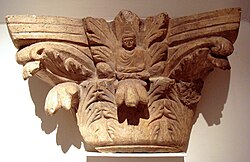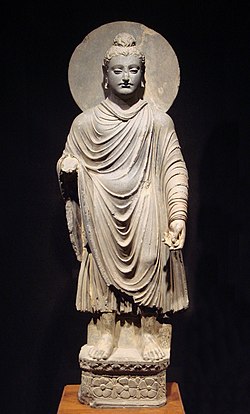Gandhárské umění
Gandhárské umění, též řecko-buddhistické, je označení pro specifický druh výtvarného umění, které začalo vznikat zcela přibližně od počátku letopočtu v oblasti Gandháry, tedy přibližně v místech dnešního Pákistánu a Afghánistánu. Zdejší kraje byly v minulosti místem, kde se setkávala antická kultura s Východem; toto střetávání kultur se mimo jiné projevilo ve vzniku specifické formy pořečtěného buddhismu (řeckého, helénistického).
Gandhárské výtvarné umění přineslo průlomovou skutečnost v dějinách buddhistického umění – pod vlivem antiky začal být zakladatel buddhismu Buddha vyobrazován v lidské podobě. Do té doby byly antropomorfní zobrazení Buddhy spíše výjimkou; Buddha byl většinou vyobrazován pomocí symbolů jako bylo např. kolo dharmy, obří stopa apod.
Galerie
- některé příklady gandhárského umění:
gandhárský Buddha z přelomu 1. – 2. století našeho letopočtu
sedící Buddha ze 4. – 6. století
brána z Bhárhutu
gandhárská hlava Poseidóna
gandhárská hlava bódhisattvy ze 4. století
Socha Buddhy s Vadžrapánim-Héraklem a Hariti-Týché
indo-korintská hlavice s Buddhou
- (c) I, Sailko, CC BY-SA 3.0
gandhárský Héraklés s nemejským lvem
Trójský kůň z příběhu o trójské válce
Externí odkazy
 Obrázky, zvuky či videa k tématu gandhárské umění na Wikimedia Commons
Obrázky, zvuky či videa k tématu gandhárské umění na Wikimedia Commons - Gandhárské plastiky ve sbírkách Národní galerie v Praze
Média použitá na této stránce
Kushan Maitreya. Musee Guimet, Paris.
Autor: No machine-readable author provided. World Imaging assumed (based on copyright claims)., Licence: CC BY-SA 3.0
The Buddha, flanked by Herakles and Tyche. Gandhara. Musée Guimet. Personal photograph 2006. While this may be the museum attribution, the figures flanking the Buddha are Hariti (with the cornucopia) and Vajrapani.
(c) I, Sailko, CC BY-SA 3.0
Wrestler's weight with Hercules and the Nemean Lion; reverse : Wrestling scene. Schist, : 10 1/4 x 13 3/4 in. (26 x 34.9 cm). Gandhara, 1st century.
Buddha within acanthus-leave capitol. Gandhara, 3-4th century. Personal photograph, Musée Guimet, 2004.
Autor: Thomas Lessman • (Contact!), Licence: CC BY-SA 3.0
The Indo-Greek Kingdoms in 100 BC..
Head of a bodhisattva, Gandhara, around 4th century, terracotta, 85 cm in height, Asian Civilisations Museum
Autor: Willard84, Licence: CC BY-SA 4.0
A seated Buddha from the Peshawar Valley (Jamalgarhi) at the San Francisco Asian Art Museum. Dated between 300 and 500 CE.
Depiction of the story of the Trojan horse in the art of Gandhara. British Museum. Personal photograph. Photographical reference here.[dead link] Another, less well preserved, frieze is known, in which warriors are seen exiting from the head of the horse. Reference p.60
Autor: Goldsmelter, Licence: CC BY-SA 4.0
Conversion of the ascetics (visit of the three Kashyapa borthers with their disciples). British Museum. Personal photograph.
Representation of the Buddha in the Greco-Buddhist art of Gandhara, 1st century AD.
Autor: No machine-readable author provided. World Imaging assumed (based on copyright claims)., Licence: CC BY-SA 3.0
Statue of Poseidon. 2nd century Gandhara. Museum of the Ancient Orient. Personal photograph 2006.



























